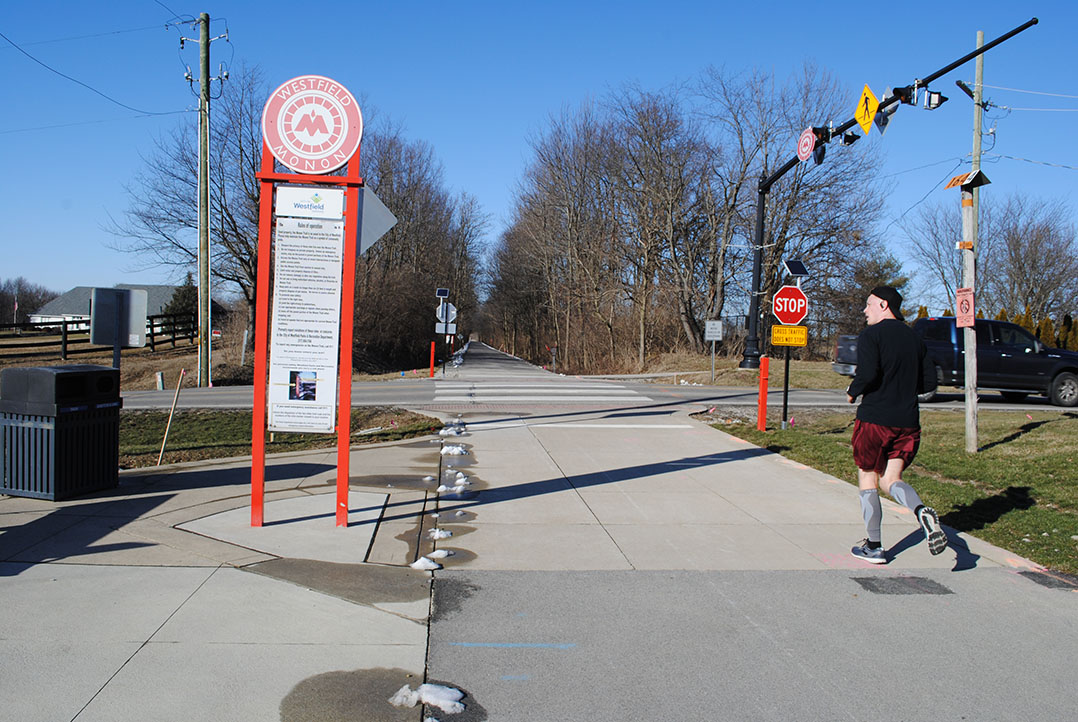When the roundabout interchange at 161st Street and U.S. 31 was constructed in Westfield in 2012, the city took proactive steps by constructing the pilings and roof of an underpass crossing at 161st Street and the Monon Trail.
The measures ensured 161st Street wouldn’t have to be closed if a tunnel was ever built for the crossing.
Years later, with the pilings and lid are still buried under the asphalt, the city still is exploring that option.
Director of Public Works Jeremy Lollar presented the proposal to the Westfield City Council at its Feb. 10 meeting after several councilors requested a presentation.
“Here in Westfield, we aren’t fortunate enough to have mountains and rivers or anything like that, but what we do have is a robust trail network, and it’s a real asset for us,” Lollar said.
When Westfield constructed its first section of the Monon Trail from 146th Street to 156th Street in 2009, it identified future concerns for certain trail crossings. Three crossings were identified: 146th Street, 161st Street and Ind. 32.
“In 2012, we partnered with the county and the City of Carmel to construct a bridge across 146th Street. Last year, we began construction of a bridge over State Road 32,” Lollar said. “Now, we are working to address the concerns at 161st Street.”
Although 161st Street is a two-lane road, Lollar expects it to be widened to four lanes by 2030. Trail traffic also is expected to continue to increase. The city signed a contract with United Consulting in 2019 for the group to evaluate and design the tunnel crossing below 161st Street.
United Consulting Vice President Chris Pope has been involved with the project since 2012 when the pilings and tunnel roof were built.
“While the interchange was being constructed at (Ind.) 31 and 161st, the mayor asked if there was something we could do to keep the road open in the future so we didn’t have to close 161st Street again,” Pope said. “That was a strain on the community to have that road closed for a long time. We came to a plan to build part of the tunnel.”
The pilings and tunnel roof were built under 161st Street, so if a trail crossing underpass is constructed in the future, the road will not close.
The project for the underpass is estimated to cost approximately $4.8 million if built in 2021. The cost is expected to rise to $6.3 million if the city delays the tunnel until it widens 161st Street in 2030.
The city has applied for grants through the Indianapolis Metropolitan Planning Organization but has been denied each time.
City Engineer John Nail said he expects Monon Trail usage to continue to increase, which could make the crossing more hazardous.
“From an engineering perspective, when you see increased traffic volumes coupled with increased pedestrian volumes, an at-grade crossing is a recipe for trouble,” Nail said. “As long as there is an at-grade crossing, you will see vehicle-pedestrian collisions.”
Although there have been no fatalities to date at the crossing, Nail said his department receives many phone calls about near misses.
Following the presentation, Lollar asked the council to provide direction at a future time on whether the city should pursue tunnel construction.
Considering other solutions
Following the presentation on the Monon Trail tunnel crossing at 161st Street, councilors asked what other solutions had been considered for the crossing besides a tunnel or a bridge.
United Consulting Vice President Chris Pope said advanced signalization is an option, but not an ideal one. Typically, the crossing becomes hazardous when a motorist stops to let a pedestrian cross the road even though the driver has the right of way.
“The city has been very proactive with signing and public education of it, but sometimes people are being polite to stop and let people cross, but that creates a problem for the pedestrian and other motorists,” Pope said. “You can signalize it, you can sign it, but those things are still going to happen even with those things in place.”
Director of Public Works Jeremey Lollar said the city has tried several unsuccessful attempts to make the at-grade crossing safer.
“We have tried gates to slow people down and bring awareness, but gates are even more hindering,” he said. “People are paying attention to the gate and not the cars.”



